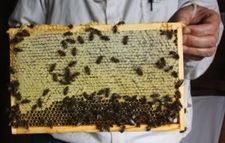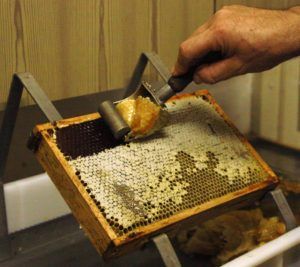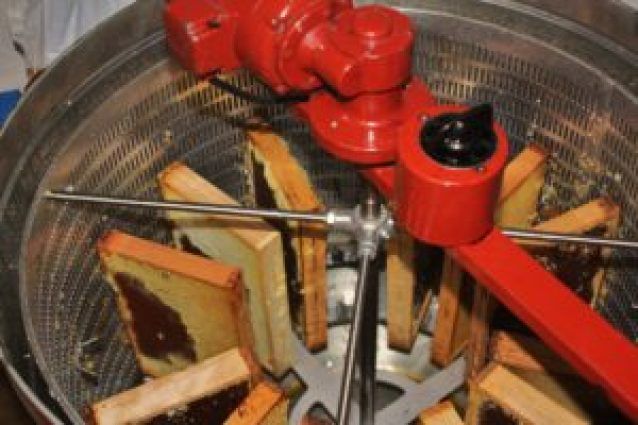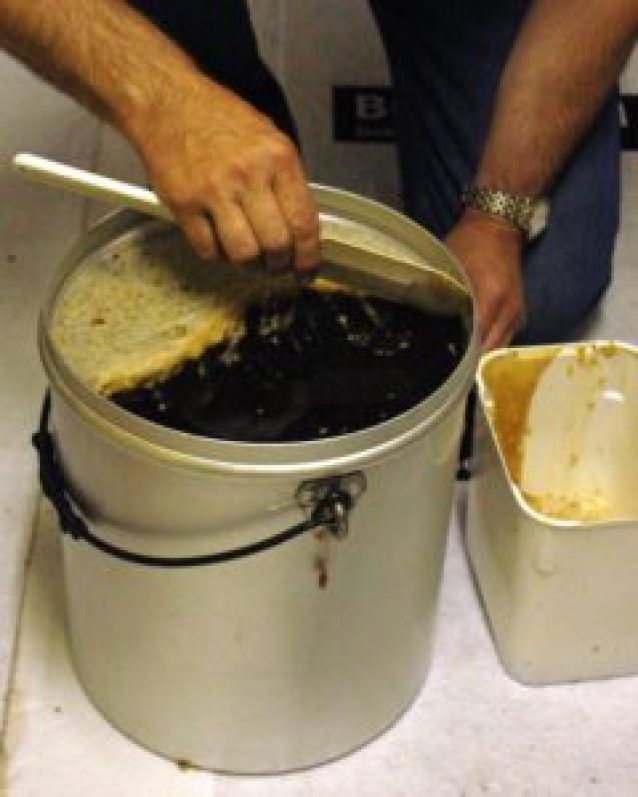It is time for the summer honey harvest. Although the bees do most the work, we as beekeepers also have a large influence on the quality of the honey. In this article, we have compiled the most important tips and tricks of the honey harvest for you.

1. Take the honeycombs from the beehive
Honey extraction is a major intervention in the bee colony. In order to avoid stress, it should be carried out as calmly and quickly as possible. The bees on the honeycombs can be gently wiped off, alternatively beekeepers who are using hive boxes can also remove the bees beforehand by using a «Bee Escape». After the removal, the honeycombs should be hung immediately in a transport frame and covered to keep the bees to stay put.

2. Uncapping the honey
You can use either a fork or a «Uncapping Plane» as shown in the image, the quickest and easiest way is by using a uncapping plane, however the uncapping plane should be heated and it is only suitable for flat honey combs. The fork is usually best to deal with an uneven honeycomb and can also be used cold.

3. Centrifuging
One can use either Tangential or Radial Centrifuges. In both cases the centrifuge should be evenly filled and slowly accelerated.

4. Skimming
After centrifuging, the honey should be left closed for 3-4 days. This will allow wax particles and any other substances to move to the surface, where it forms a kind of foam. This foam can be skimmed off with a scoop and used to make fondant feed for the bees. To remove the finest particles one should filter further with sieves or a cheesecloth.
5. Stirring and inoculating (optional)
Both processes accelerate the crystallization of the honey and promote a fine crystalline, creamy consistency.
During stirring, the earliest formed crystals are broken and redistributed through the honey. This will improve the honey’s consistency. The honey should be stirred at least once a day for 10-15 minutes until the desired consistency is achieved.
By inoculating 5-10% fine crystalline honey is added to the honey. This so-called «starter» is than stirred in at a temperature over 25°C. Afterwards, the honey should be stored in a cool place.
6. Storage
Preferably, the honey is directly stored in small jars ready for sale. In this way the honey does not have to be transferred into different containers again. If this is not possible and you have to store the honey in different containers at different moment in time, be careful when transferring the honey. The honey has of course, be heated in order to liquify it, however the heating can result in HMF (5-hydroxy-methylfurfural). HMF is used as an indication for the honey quality and a HMF content over 40 mg/kg is not permitted in Switzerland and the EU. Also, if you want to produce the high quality «gold seal» honey in Switzerland, the HMF content should not be over 15 mg/kg.
Nevertheless, if liquification cannot be avoided, the honey should only be heated as briefly as possible and not above 40°C (the easiest way to do this is to use equipment specially manufactured for liquification of honey).
Additionally, a dry, dark and cool room is best suited for storage. As storage at too high temperatures can also increase the HMF content of the honey. Lastly, warmth and light can destroy the enzymes in the honey and high air humidity can increase the moisture content.
How a low moisture content can be achieved
Harvesting capped honey
Only honey with a moisture content below 17% will not ferment and can therefore be stored indefinitely. Ideally, the honey’s moisture content should be less than 17.5% (gold seal honey: < 18.5%, swiss food law: < 21%). Therefore, the honey should be harvested with the lowest possible moisture content. At best, mostly capped honey is harvested (75-100%). In case of uncapped honey, the moisture content can be checked with a refractometer (be sure to measure multiple times as each cell can have a slightly different moisture content). Another method is the shock test, during the shock test, the honeycomb is held horizontally and abruptly moved downwards – if the honey does not drip out of the honeycomb it can be considered ripe.
Dry harvest and storage
The moisture content is also dependent on several factors during the honey collection and harvest and can be influenced by various measures. First, the size of the beehive should be adjusted to the strength of the bee colony before the harvest. If the hive is too large, the bees retreat into the brood chamber at cool temperatures, this causes water to condense in the insufficiently occupied honey combs which increases the moisture content. For the same reason, a bee escape should not be used in humid weather and should only be left on the hive a short time before the honey extraction. Second, in order to keep the moisture content as low as possible during harvesting, the honeycombs should be harvested in warm, dry weather and centrifuged immediately afterwards. As honey can take up moisture from the air, the centrifuge room should have a low air humidity. Be sure to store the honey in tight containers. Finally, to prevent fermentation a short storage time and a low storage temperature is advisable. Be aware that the optimal temperature for fermentation is between 20°C and 30°C.
Sunny location
Beside the beekeeping practice, environmental factors also influence the moisture content. In sunny, warm locations the honey logically has a lower moisture content than in cool and humid locations. Furthermore, the moisture content is generally lower in a Swiss Beehouse compared to outdoor hive boxes, presumably because of differences in insulation and air circulation. Further, the location of the bees is also an important factor. Especially during mass flowering it is difficult for the bees to completely thicken the honey and even capped honey can have a relatively high moisture content. Lastly, honey with a high glucose and melezitose content crystallizes faster, which also increases the moisture content. This is why rapeseed and dandelion honey are particularly affected by fermentation and should only be harvested from capped honey combs.
How crystallization can be enhanced
Fine crystalline, creamy honey is preferred by most consumers and is produced by a rapid crystallization process. The beekeeper can improve the honey’s consistency by stirring or inoculating, but it also depends on the storage temperature, the moisture content and the sugar composition of the honey. Storage temperatures of 14-15°C facilitate the desired rapid crystallization. In addition, honey with a moisture content between 15-18% and more than 30% glucose crystallizes relatively quickly. Alpine rose-, lime, dandelion and rape nectar usually contains such a high level of glucose and these honey types usually already have the desired consistency. In contrast, sweet chestnut, acacia and honeydew honey crystallizes slowly and after years of storage, it can turn into coarse and inedible honey. In the case of honeydew honey from spruce and larches, the melezitose content can exceed 10%. In this case, the crystallization occurs very quickly and can already happen in the honeycomb. This «cement honey», cannot be centrifuged and usually cannot be liquified by elevated temperatures. Furthermore, cement honey causes dysentery with the bees and is unsuitable as winter food. It can, however, be stored and used as an supplementary food source for after the spring honey harvest. In order to make it easier for the bees to digest cement honey, the honeycombs can be dipped in warm water before being placed in the hive.
How to avoid contamination
Beekeeping practice
Honey contamination can be caused by environmental influences, however the majority of contaminations are the result of the beekeeping practice. Rusty honey centrifuges and unsuitable storage containers can cause contamination from heavy metals and chemical substances. Further, strong odours can change the aroma of the honey, for example by using a lot of smoke when removing the honeycombs from the hive or by centrifuging and storing the honey in musty rooms.
Traces of Varroa treatments with synthetic substances (Amitraz, Coumaphos, Fruvalinate, Flumethrin, Cymiazol), which were applied in autumn can still be found in the honey the following spring. If natural substances (thymol, formic and oxalic acid) are used, the contamination is ususally very low or even non-existent when the treatment is carried out after the honey harvest. However, if thymol and formic acid treatments are applied during the flowering times, contamination and changes in taste may occur.
Contamination can also be caused by combating wax moths with para-dichlorobenzene (PDCB) or naphthalene. In 2004, 34% of the honey in Switzerland was contaminated with PDCB, of which 13% exceeded the critical threshold (0.01 mg/kg). Therefore try to avoid, if possible, wax moth treatment with PDCB. Wax moths can be combated with acetic or formic acid or kept in moth-tight honeycomb cabinets. Separate storage of brood and honeycombs can also help, as the moths prefer brood combs.
Environmental influences
Contaminations from the environment often play a minor role. However, various pesticides from agriculture can get into the honey. In Europe, between 20% and 50% of honey is contaminated with pesticides – partly with substances that have been banned for years, but are still present in the environment. These residues rarely exceed the permitted thresholds and therefore pose no risk to human health.
However, some substances are highly toxic to bees and pesticide residues in honey might be a danger for the bees health. Also heavy traffic in the vicinity of the apiary can cause contamination: heavy metals from car exhausts can end up in the nectar via the air. This harmful environmental influences can only be countered by choosing a location in an well-managed and low-traffic environment.
Literature
1 Bogdanov, S., Bieri, K., Holeiter, M., Rieder, K. & Matzke, A. Das Schweizerische Bienenbuch – Bienenprodukte und Apitherapie. VDRB (2014).
2 Brägger, J. et al. Das schweizerische Bienenbuch – Imkerhandwerk. VDRB (2014).
3 Bogdanov, S. & Kast, C. Welche Massnahmen helfen den Wassergehalt in den Griff zu bekommen? Schweizerische Bienen-Zeitung 2014-7, 25-27 (2014).
4 Bogdanov, S. Lagerung, Kristallisation und Verflüssigung des Honigs. Schweizerisches Zentrum für Bienenforschung (1999).
5 Bogdanov, S. Contaminants of bee products. Apidologie 37, 1-18, doi:10.1051/apido:2005043 (2006).